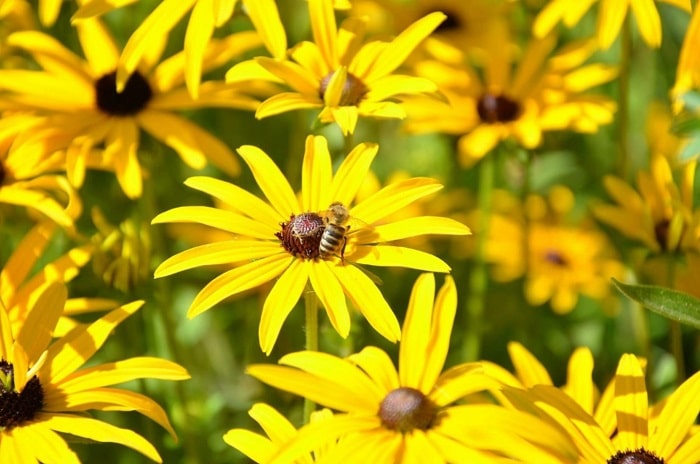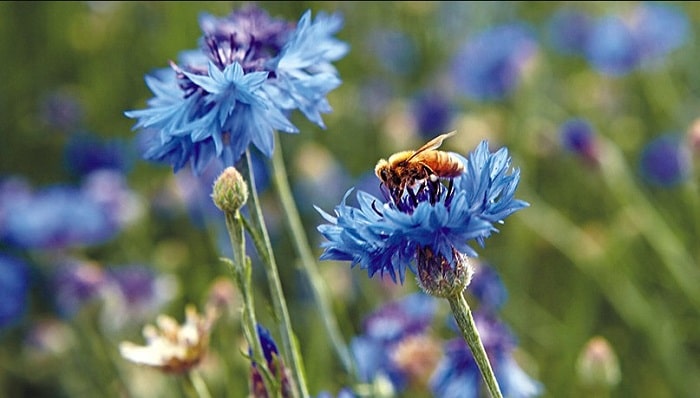You are probably aware that native bees are responsible for roughly one-third of our food supply. Bees play an important role in our entire ecosystem. Without their assistance, it would be a fruitless crop! Here is a list of the best flowers for bees.
Naitive bees are pollinating powerhouses
The majority of pollination is done by native pollinators such as flies, beetles, moths, and butterflies, but native bees are the unsung heroes. There are about 4,000 native bee species in North America, ranging from the world’s tiniest bee, the 2mm long fairy bee (Perdita minimum), found exclusively in the desert southwest, to huge carpenter bees that exceed 40mm in length.
All native bees, regardless of size, rely on blooming plants for sugary nectar and protein-rich pollen to nourish themselves and their offspring. Flowers must be in bloom throughout the season to provide bees with the nutrition they require. Grow a variety of shapes and sizes to provide something for everyone.

How to choose best flowers for bees?
Some flowers are preferred by bees over others for a variety of reasons. In general, it comes down to the flower’s shape and color. When planning to plant flowers for bees, keep the following points in mind:
- The length of a bee’s tongue influences its floral preferences.
Some bees have long tongues that allow them to quickly reach nectar from tubular-shaped flowers such as penstemon, columbine, and honeysuckle. Short-tongued people prefer daisies, asters, and sunflowers. Small florets and composite blooms are preferred by small bees, whilst larger blossoms are preferred by bumblebees and carpenters. Plant a range of flower shapes and sizes to attract a variety of bee species to your property.
- Flower color matters
Hummingbirds and butterflies prefer the color red, which bees cannot see. Bees are attracted to the colors purple, blue, white, and yellow.
- Pollinators generally prefer native plants.
Native plants are typically low-maintenance, suitable to your region, and readily available for purchase. When it comes to attracting pollinators and providing them with what they require, species plants have an advantage over cultivars.
- Chemical-free
Do not use pesticides on your flowers because they are particularly hazardous to honeybees and other useful insects. Instead, use eco-friendly remedies and apply them early in the morning or late at night, when there are few bees about. Also, avoid purchasing plants that have been prepared with systemic pesticides, which can be toxic to bees even in little doses.
List of flowers that attract bees
There are some exceptions to the rule that perennials provide the best nectar and pollen. Some bees are specialized, such as the squash bee, which only pollinates squash, pumpkin, and gourd blooms. The most effective pollinators are generalists that feed on a wide variety of plants. This contains not just native trees and perennials, but also some non-natives such as crimson and white clovers, as well as annuals.
*** Early-season flowers for bees
Finding enough food in late winter and early spring, when most of nature is still sleeping, is an ongoing battle for temperate zone bees. Here are some ideas on what we might grow to help them:
- Vernal witch hazel, maples, willows, serviceberry, and redbud are some early blooming plants and shrubs to consider. They bloom when there isn’t much else in bloom.
- Fruits that bloom early, such as cherry, plum, raspberry, blackberry, and blueberry.
- Spring-flowering bulbs are also popular with early awakening bees.
- Golden alexanders, larkspur, dianthus, wild columbine, ajuga, lupine, baptisia, and pulmonaria are some spring perennials to grow.
*** Mid-season flowers for bees
Mid-season flowers that attract bees include anise hyssop, black-eyed Susans, coneflowers, catmint, cleome, penstemon, globe thistle, milkweed, monarda (bee balm), coreopsis, daisies, phlox, gaillardia, and yarrow.
- Cleome, often known as “spider flower,” is a favorite of pollinators and has a long blooming season.
- “Bee balm” is an apt name of this flower, which is native to North America. Bees love it
- Yarrow has an easy landing pad which makes it easy for pollinators to take a rest
*** Late-season flowers for bees
Bees are active until the weather cools down in late fall, yet they still require food. To keep the party going, plant some late bloomers like dahlias, asters, ironweed, goldenrod, Joe Pye weed, rudbeckias, and helianthus. Bottle gentian is also popular among bumblebees.

>>> Read more: What Does Bees Like To Eat? – Things to Know
Bee garden design tips
There are other things you can do in your yard to keep bees abuzz besides planting vibrant flowers. Here are some ideas for constructing the ultimate pollinator haven:
- Provide a comfortable home
Not all bees, like the super-social honeybee, colonize hives. Bumblebees build their nests in holes in the ground and require bare regions of unmulched soil in which to excavate their underground tunnels. Certain solitary bees live in above ground tunnels or caverns in hollow-stemmed plants and dead wood. You can buy or create a “bee hotel” for these hole-nesting bees, which is a birdhouse-like structure made of hollow reeds or cardboard tubes.
- Make sure they have access to water.
Make a small bee watering station in the garden by placing a shallow, wide dish filled with clean water and a few stones for the bees to stand on. A birdbath with a few smooth rocks inside may also suffice. Another alternative is to purchase a gravity-fed water dispenser made specifically for bees.
- Plant a bee lawn and some herbs
This comprises both low-growing floral plants and turf grass. Plants that help pollinators and will flower in a manicured lawn include Dutch white clover (Trifolium repens), creeping thyme (Thymus serpyllum), and native violas (Viola spp.). Even dandelions can be useful in attracting bees and other pollination insects.
Keep in mind that most bee-attracting plants require full sun for at least half of the day. Plant your bee flowers in containers and place them on a sunny patio or balcony if you don’t have a sun garden.
>>> View more: TOP 10 Best Beekeeping Suits Reviews & Buying Guide
